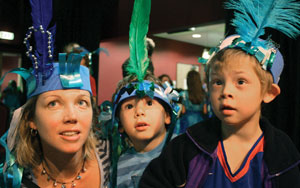Local authority arts departments are facing a challenging time. Lorna Brown gives us an overview of the pressures, politics and possibilities.

The past decade has seen massive investment in the arts. Many shiny new buildings stand testament to this, along with multi-million pound initiatives such as Creative Partnerships and Find Your Talent. Arts Council England has secured funds from central government, and the National Lottery has put many millions into the system. Local government has been a key player too, building its own facilities, contributing to others, providing grants to everything from national companies to individual artists, tiny community arts projects and amateur societies. Local government also runs theatres, galleries and arts centres, supports creative industries and provides arts development services. The total invested by local government is a major source of funding for the arts – and that’s without counting youth orchestras, county drama and dance companies, art and craft sessions in residential and day care centres, youth service arts, library arts activities, and before you even get to arts in schools.
But this rosy picture has a darker underside. Local government budgets have been under considerable pressure and finding more ‘efficient’ working methods has been called for. We rarely hear about ‘cuts’ in local government circles, only ‘savings’ or ‘efficiencies’. All the more worrying, then, that ‘cuts’ have moved centre stage.
Breaking Down The Budget
Council spending overall has gone up in the past five years by about 25%. Over half of local government’s money comes from central government as a grant or ‘settlement’. Council tax makes up about a quarter, with the rest from other sources such as earnings and investments. Income has also gone up over that five-year period, but while Council tax has gone up by 25% or so the amount from central government has increased by only 12%. And that’s overall – the amount that individual councils have received varies very widely. It’s also the case that what national statistics group as ‘cultural, environmental and planning’ expenditure has gone up by about 25%, broadly similar to social care or education. But this masks a massive diversity of local differences when you get to how arts services and funding have fared.
Nalgao carries out an annual spending survey that shows many arts service budgets have kept pace with inflation, and many have seen real increases. Others have seen significant losses, some have gone to the wall, and we have lost some 40 arts services over the past five years. Now we face a serious situation with the settlement expected to be tighter, investment returns down and costs up even further.
Making The Case
The good news is that five years ago, the arts were often seen as an easy target when councils were looking to save money, and that is far less often the case now. Arts officers and arts organisations have shown that the arts make places better to live in, bring people together socially and culturally, can help achieve the aims of others such as health and education, and are important economically. That won’t save us entirely, there are hard decisions to be made by councils trying to balance the books, but the arts spending isn’t automatically top of the list.
Arts officers have long had to play the funding game every bit as much as arts organisations, winning Arts Council England and Arts Council of Wales funding, making their own Grants for the arts bids, winning over the Heritage Lottery Fund, forging partnerships with other council services, such as social services and education, and other partners, such as health. Those are the kind of partnerships that underpin the thinking behind ‘strategic commissioning’ – something we are increasingly hearing about. It’s all too easy once you start talking about what local government and its partners do, to disappear into a fug of jargon around ‘outcomes’, ‘priorities’ and ‘improvement’, but the key message is that this is about tackling local concerns jointly – be those anti-social behaviour, obesity, regeneration or better relationships between different communities. The arts can do those things and do them well: the great skill is ensuring the arts benefit too.
There is much second-guessing about where we’ll be next summer, what government (whichever that is) policy will be and how that will affect us. Would a Conservative government really mean a less instrumental future for the arts? If so, given local council money is public money, is it really likely to mean the need to demonstrate local benefits will end? There is a clear sense that tectonic plates are shifting; we are soon to be in a period of transition: the difficulty is we don’t know to what. Arts people, be they inside or out local government, will as ever step up to the challenge.
Lorna Brown is Chair of nalgao, the National Association of Local Government Arts Officers.
w http://www.nalgao.org
This week Lorna took a quick tour of the National Gallery and was once again awestruck at its richness. She also attended a special event – the R&D launch of Ravel’s ‘L’enfant et les sortilèges’, part of West Sussex’s 2012 programme with animation, puppets, possibly a touring tent, and a children’s chorus. Local children worked with musical directors, and performed a taster with skill and enthusiasm – a real joy!



